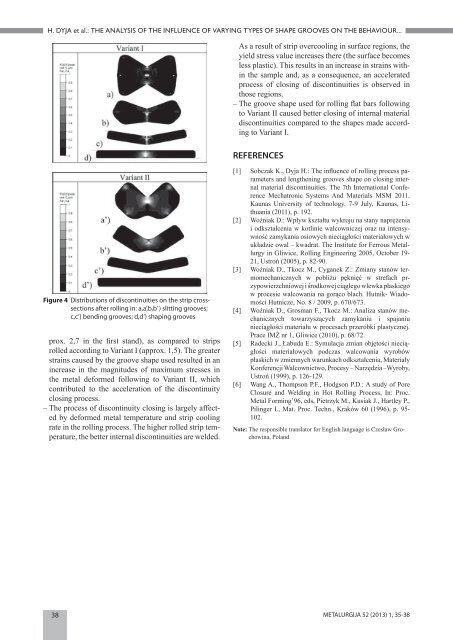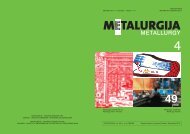Metalurgija: sadašnjost Metallurgy: Present Metalurgija ... - CARNet
Metalurgija: sadašnjost Metallurgy: Present Metalurgija ... - CARNet
Metalurgija: sadašnjost Metallurgy: Present Metalurgija ... - CARNet
You also want an ePaper? Increase the reach of your titles
YUMPU automatically turns print PDFs into web optimized ePapers that Google loves.
H. DYJA et al.: THE ANALYSIS OF THE INFLUENCE OF VARYING TYPES OF SHAPE GROOVES ON THE BEHAVIOUR...<br />
Figure 4 Distributions of discontinuities on the strip crosssections<br />
after rolling in: a,a’,b,b’ ) slitting grooves;<br />
c,c’) bending grooves; d,d’) shaping grooves<br />
prox. 2,7 in the fi rst stand), as compared to strips<br />
rolled according to Variant I (approx. 1,5). The greater<br />
strains caused by the groove shape used resulted in an<br />
increase in the magnitudes of maximum stresses in<br />
the metal deformed following to Variant II, which<br />
contributed to the acceleration of the discontinuity<br />
closing process.<br />
– The process of discontinuity closing is largely affected<br />
by deformed metal temperature and strip cooling<br />
rate in the rolling process. The higher rolled strip temperature,<br />
the better internal discontinuities are welded.<br />
As a result of strip overcooling in surface regions, the<br />
yield stress value increases there (the surface becomes<br />
less plastic). This results in an increase in strains within<br />
the sample and, as a consequence, an accelerated<br />
process of closing of discontinuities is observed in<br />
those regions.<br />
– The groove shape used for rolling fl at bars following<br />
to Variant II caused better closing of internal material<br />
discontinuities compared to the shapes made according<br />
to Variant I.<br />
REFERENCES<br />
[1] Sobczak K., Dyja H.: The infl uence of rolling process parameters<br />
and lengthening grooves shape on closing internal<br />
material discontinuities. The 7th International Conference<br />
Mechatronic Systems And Materials MSM 2011.<br />
Kaunas University of technology. 7-9 July, Kaunas, Lithuania<br />
(2011), p. 192.<br />
[2] Woźniak D.: Wpływ kształtu wykroju na stany naprężenia<br />
i odkształcenia w kotlinie walcowniczej oraz na inten sywność<br />
zamykania osiowych nieciągłości materiałowych w<br />
układzie owal – kwadrat. The Institute for Ferrous <strong>Metallurgy</strong><br />
in Gliwice, Rolling Engineering 2005, October 19-<br />
21, Ustroń (2005), p. 82-90.<br />
[3] Woźniak D., Tkocz M., Cyganek Z.: Zmiany stanów termomechanicznych<br />
w pobliżu pęknięć w strefach przypowierzchniowej<br />
i środkowej ciągłego wlewka płaskiego<br />
w procesie walcowania na gorąco blach. Hutnik- Wiadomości<br />
Hutnicze, No. 8 / 2009, p. 670/673.<br />
[4] Woźniak D., Grosman F., Tkocz M.: Analiza stanów mecha<br />
nicznych towarzyszących zamykaniu i spajaniu<br />
nieciągłości materiału w procesach przeróbki plastycznej.<br />
Prace IMŻ nr 1, Gliwice (2010), p. 68/72.<br />
[5] Radecki J., Łabuda E.: Symulacja zmian objętości nieciągłości<br />
materiałowych podczas wal cowania wyrobów<br />
płaskich w zmiennych warunkach odkształcenia, Materiały<br />
Konferencji Walcownictwo, Procesy – Narzędzia –Wyroby,<br />
Ustroń (1999), p. 126-129.<br />
[6] Wang A., Thompson P.F., Hodgson P.D.: A study of Pore<br />
Closure and Welding in Hot Rolling Process, In: Proc.<br />
Metal Forming’96, eds, Pietrzyk M., Kusiak J., Hartley P.,<br />
Pilinger I., Mat. Proc. Techn., Kraków 60 (1996), p. 95-<br />
102.<br />
Note: The responsible translator for English language is Czesław Grochowina,<br />
Poland<br />
38 METALURGIJA 52 (2013) 1, 35-38
















